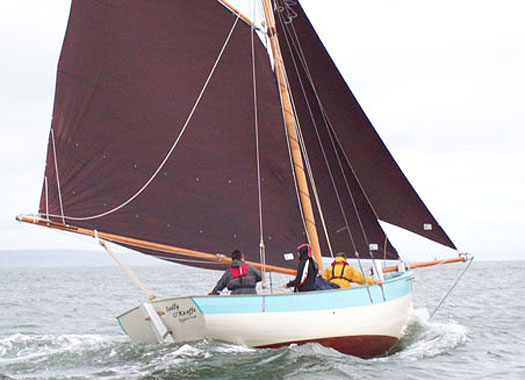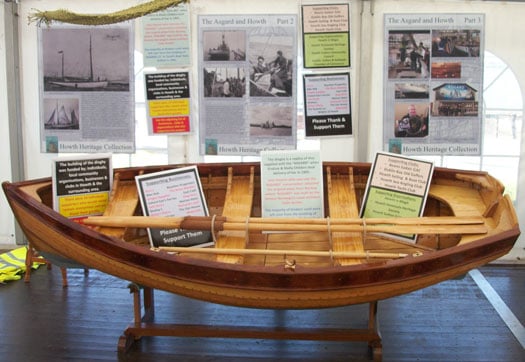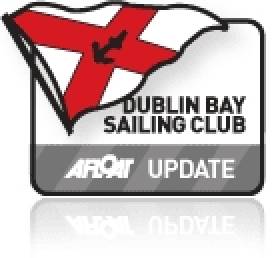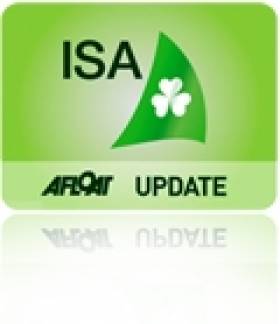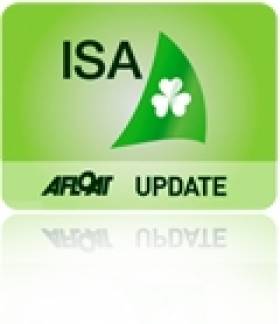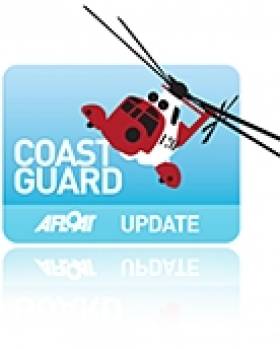Displaying items by tag: Dinghy
Vintage 1977 Laser Sailing Dinghy (With No Leaks) For Sale
#laserforsale – A vintage 1977 example of one of the most popular single-handed dinghy designs in the world is for sale on Afloat boats for sale site at €950. Fully equipped and with top cover this Laser dinghy (Sail number 43338) is ready to sail away, according to seller Michael, who also offers delivery for a modest fee. Click for more details and specification on this retro Laser for sale.
#woodenboat – The wonderful world of Ireland's wooden boats is a winding trail. W M Nixon went to West Clare to see one boat, but unexpectedly happened upon another with which he was totally smitten. Then he found the original objective of his travels was even better than expected. And finally back home, he found the project to re-create Asgard's 10ft dinghy from 1905 has produced a gem of classic boat-building.
With Sally O'Keeffe, it's love at first sight. I defy anyone to resist the allure of this shapely beauty.
You may have heard of this community project in southwest Clare, to build a replica of the working cutters which used to ply their trade in the demanding waters of the Shannon Estuary. And like me, you may even have noted with pleasure that the designer to the project was Myles Stapleton of Malahide, the great unsung star of Irish naval architecture, who has never drawn an unharmonious line in his life.
Yet like me, while you may have been aware that the boat was first launched in 2012, somehow neither of us has ever been in the presence of this remarkable little ship. And this despite the fact that she has been cutting a swathe through the fleet at classic and traditional events between Galway Bay and Baltimore for the past year and more.
Even with all this, I was actually trying to find the whereabouts of another new wooden boat entirely when I stumbled upon Sally O'Keeffe - newly-launched in Kilrush last Saturday - and was instantly smitten. For she's only gorgeous. She looks so utterly right, she's mad keen to sail which she does very well indeed, and she brings much pleasure to everyone involved. This has to be the community project par excellence. But then, Querrin in West Clare is a genuine community par excellence, an idea and vision as much as a place.
It's spread out on your left down towards the Shannon Estuary as you enter the Loop Peninsula, which is Ireland's ultimate place apart. Loop Head's island atmosphere is very marked, with the extensive but shallow Poulnasherry Bay west of Kilrush pushing northwest deep into the land, almost to Kilkee. Thus places like Querrin, until well into the 19th Century and even later, were much reliant on goods being landed at and exported from their little quays.
The Shannon Estuary is a mighty highway, but with the biggest tides in Ireland – 5.6 metres range at top of springs – the workboats carrying the vital goods had to be multi-functional and capable of taking aboard diverse cargoes. Not least of the requirements was a good all-round sailing ability, for although the Galway Hookers away to the north largely plied their trade by reaching back and forth across Galway Bay from Connemara to the Aran Islands, the Shannon Hookers had to excel in windward ability in order to sneak along inside the inevitable foul tides, and weather the increasingly difficult headlands which they encountered as they made their way west. Thus the boats which regularly sailed to Querrin were among the most able on the estuary, and long after the last of them sailed, the folk memory of their significance lingers on.
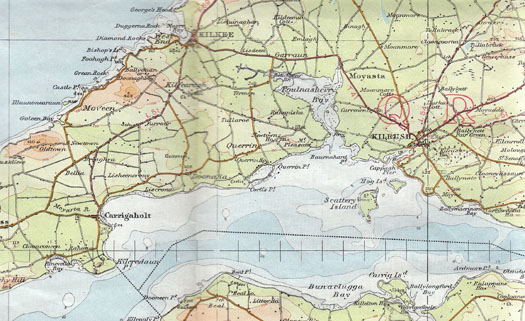
Querrin at the heart of things. Once you get west of Poulnasherry Bay, you're in the remote island-like atmosphere of the Loop Head Peninsula. Loop Head itself is another six miles west of the left edge of this map

Sally O'Keeffe provided a formidable design challenge for Myles Stapleton, as he had to create a roomy and high freeboard hull which still managed to incorporate elegant curves, yet all within an overall hull length of only 25ft. And of course, she had to sail very well too. Photo: W M Nixon
It was thought that the ribs of one of the old sailing workboats were sticking out of the mud at Blackwater Bridge on the road approaching Querrin from Moyasta. So as a local Querrin Sailing group began to gain traction, they got the notion of getting those last remains out of the mud, and restoring a proper Shannon Hooker to be the flagship of their little fleet, and the focus of a worthwhile community project in boat-building.
Perhaps it's as well the old wreck proved to be no more than shallow-water cot, for this seeming disappointment led eventually to designer Myles Stapleton and a magnificent but manageable project to build a new 25ft Shannon Hooker, using ancient photos and old drawings to re-create the best of the type.
In Querrin, Ned Griffin lent his fine shed up the hill for building the new boat, and as she took shape he also came up with the perfect name. In the 19th Century, Sally O'Keeffe had been the wife of a Querrin-based sailing workboat skipper, and she was a woman still remembered. It's a name of great style, but lest anyone think it's just too good to be true, let it be known that in 2012 as the new boat was making her debut, didn't Sally O'Keeffe's grandson – aged a hundred – return from America to give his blessing?
The building had started in 1910, and this Seol Sionna project drew on many sources and much voluntary labour, both within southwest Clare and further afield, to reach completion. They had the benefit of the extensive knowledge of traditional craftwork guru Cristoir Mac Carthaigh, who may be best known for his work in traditional boats, but if you've a bit of old-style thatching in mind, he can help you there too.
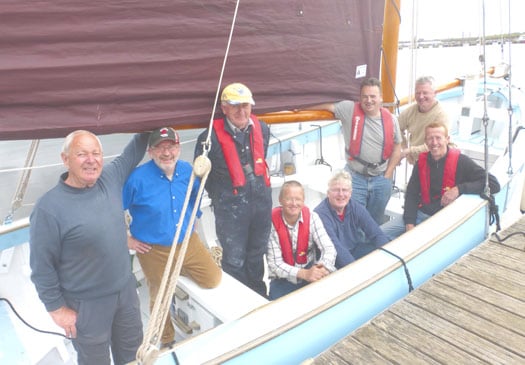
Some of the team at Querrin Sailing who built and sail the Sally O'Keeffe. Seen aboard on launching day at Kilrush are (left to right) Joe Hassett, Criostoir Mac Carthaigh, Michael O'Connell, Stephen Morris, Dixie Collins, Fintan Ryan, John Kennedy and Stephen Courage. Photo: W M Nixon

Steve Morris. Photo: W M Nixon
As for the building team, the trainee boatbuilders ranged in age from 16 to 80. It all became very possible thanks to Steve Morris, a fully-qualified New Zealand boatbuilder who came to Ireland a long time ago while taking a world backpack tour, and somehow stayed. He got involved in the building of the Jeannie Johnston on Tralee Bay in 1986, and for several years now he has lived near the shores of Poulnasherry Bay, and is a pillar of the maritime scene locally and nationally.
Steve served a full five year apprenticeship in boat-building in Auckland, so the community boat-builders of Querrin have had guidance and teaching of gold standard. In fact, thanks to Steve's input and the enormous goodwill and enthusiasm which the project engendered, it's doubtful if she could have been better built anywhere else in Ireland, while this video of him demonstrating caulking skills shows the standards to which they worked.
The ethos underlying the project has been eloquently articulated by Richard "Dixie" Collins, another of the key movers and shakers in Querrin Sailing:
"This is very much a community project from Loop Head peninsula. A keen, salty group who are sharing skills and enthusiasm for getting out on the ocean, to a place with a big sky and lots going on. There is training in seafaring skills for people who have never been out in a boat, and we provide trips to islands, and old piers which were built for boats like this in another time.
Our logo is taken from a gravestone in Scattery Island church of a boat-builder by the name of O'Mahony in 1832. In this small rural part of the western seaboard, we have built a sailing boat which we can maintain ourselves, and we offer sailing opportunities for everyone in the area for a five euro contribution to the club. An important outcome is the capacity building with new relationships, generational sharing of learning and having a right good time ourselves. It strengthens our sense of community, and is a shared credit to the collective efforts of everyone."
Despite the robust hull's obvious sailing power, Sally O'Keeffe needs only one hand on the tiller.
As the Sally O'Keeffe was going to be kept undecked with her hull limited to 25ft overall, for safety reasons they had to ask Myles Stapleton to give her quite high freeboard. It says everything about his skills as a creator of good-looking boats that despite the high freeboard – which has proven a Godsend in both the Estuary and on some remarkable and swift coastal passages on the open Atlantic north to Galway and south to Baltimore – the Sally O'Keeffe has a tremendously vigorous style to her appearance. It lifts the spirits just to see the sweep of her sheer and the elegant way in which the transom stern is incorporated in a sweet yet powerful run aft.
In 2013 she sailed forth more than seventy times, and while the highlights were the voyages to Galway and Baltimore, the essence of her popularity is the shorter jaunts within the Estuary, captured very effectively on this brief video by John Collins taken aboard after overnighting with a camp on Canon Island.
Despite a tiller of only average length, she is easily steered – in fact, "finger-tip control" is the theme of much of her sailing. As for her speed, it has pleasantly surprised everyone involved, and the visit to Baltimore found the little 25-footer from the Shannon pacing with or even over-taking the 33ft mackerel yawls from West Cork.
The Baltimore Wooden Boat Festival (this year's is from 23rd-25th May) is the gathering of the crème de la crème of Ireland's wooden boatbuilders. The very fact that they can be up and running so early in the season is proof they're the tops, but as the Baltimore maritime calendar is so full of events, this is when the timber tribe has to take to the seas, even if many older wooden boats elsewhere in Ireland seldom put a toe out until June.

At the Baltimore Wooden Boat Festival 2013, Sally O'Keeffe found herself pacing with the larger 33ft West Cork mackerel yawl

Baltimore Wooden Boat Festival gathers the crème de la crème of the traditional and classic boat-building brotherhood. This is Rui Ferreira of Ballydehob sailing the Castlehaven Ette Class dinghy which he built, with Sally O'Keeffe in the background making her Baltimore Debut
Meanwhile, nearer home, Querrin Regatta is today. That's right, Saturday May 10th. Unfortunately the weather prospects aren't great, with the jet stream squatting over Ireland like some vast demented dragon. But at least the Sally O'Keeffe is in proper order, as she demonstrated during some heavy weather sailing in the Estuary on Bank Holiday Monday. And the famous West Clare racing currachs are up for it too – last Sunday we saw one of the renowned Doonbeg racing currachs in intensive training off their little port, where the inner reaches now have a handy pontoon in a pool in the river.
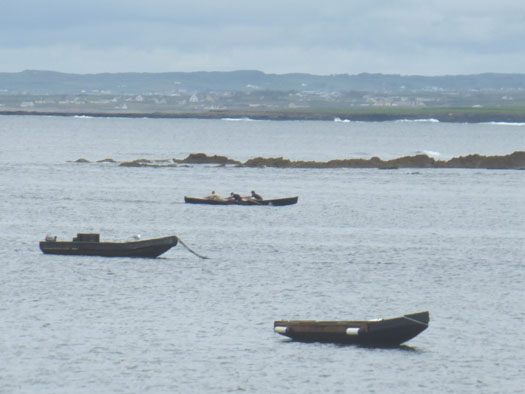
The western way. Racing currach at Doonbeg in training on Sunday morning. Photo: W M Nixon
One local boat which definitely won't be at today's Querrin Regatta is the reason we ended up in Kilrush in the first place. This is Steve Morris's own special pet, and it was Kim Roberts of Askeaton who suggested that this was worth seeing. It certainly is. He has taken a classic Harrison Butler Khamseen design, which is remarkably like an anticipation of Lyle Hess designs like Fred Schotman's Raven from the Netherlands which was in Dublin Bay last year, and is creating his dreamship at home.
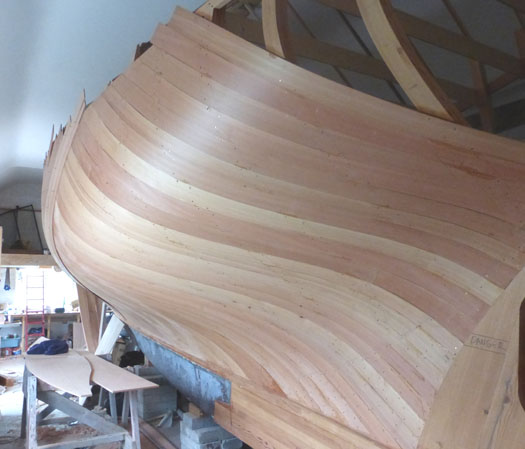
The port side of Steve Morris's 31ft Harrison Butler design looking forward, with the rich texture of the Alpine larch glowing through. Photo: W. M. Nixon
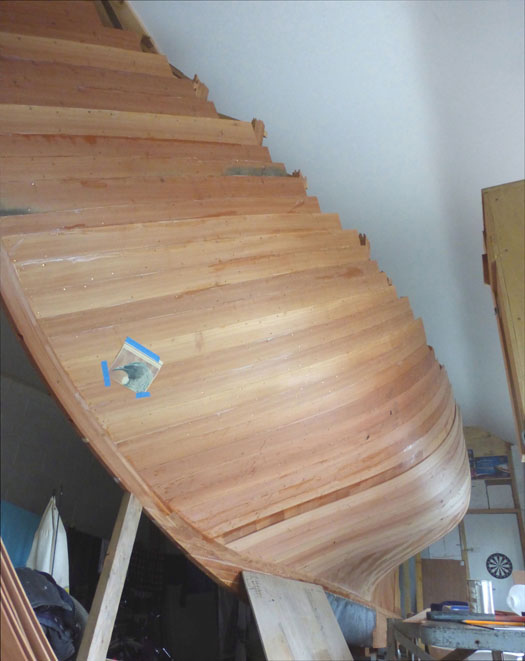
Don't try this at home.....Steve Morris has managed to fit this 31ft hull into the garage beside his house. Photo: W M Nixon
Steve is building this honey of a boat in multi-skin, using dark dense Alpine larch, the leftovers of a consignment of timber which was brought in from Austria for the building of Jeanie Johnston. The man works so neatly that he has managed to fit the entire project into the admittedly spacious garage beside his house near Moyasta, and the workshop is one of those spiritually-enhancing places which are a balm for the soul.
Particularly impressive is the perfectly-shaped lead ballast keel which fits so well into Harrison Butler's flowing lines. And it's typical of this job too. For when I asked him who made the form and cast the keel for him, he was surprised by the question, as the answer simply is: "I did it myself, right here on site".
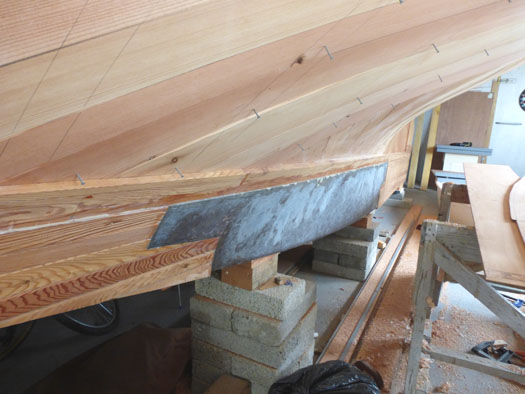
"No problem". The lead ballast keel was cast on site. Photo: W M Nixon
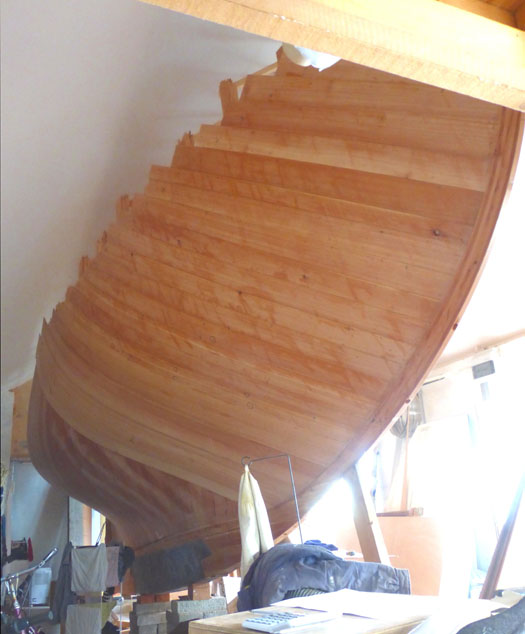
Even with quite a large garage, it's very difficult to get a photo showing all of a 31ft boat. Starboard side looking aft. Photo: W M Nixon
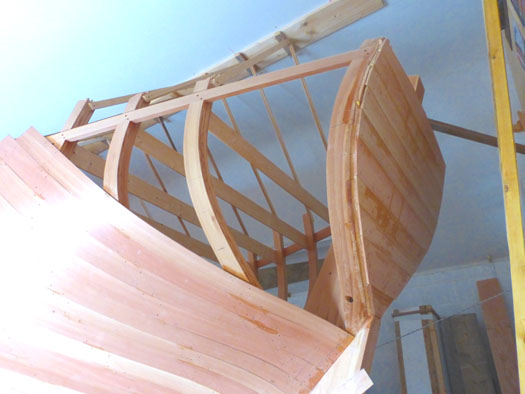
Although the Metacentric Shelf theory of hull design to which Harrison Butler subscribed has been large disproved, he still produced hulls of balanced performance with transom sterns which didn't drag half the ocean after them. Photo: W M Nixon

A dartboard is an essential in any boatbuilding shed. You need something to keep you well away from the job while glue is setting. Photo: W M Nixon
Using "leftover" timber for boat-building projects is an appropriate theme as we emerge from recessionary times. After John Kearon and his team had made such a fine job of conserving Asgard, there were bits and pieces of well-seasoned leftover wood, and they provided enough timber for Pat Murphy and his group of support volunteers to put in train the building of a replica of Asgard's original 1905 10ft dinghy, designed by Colin Archer himself.
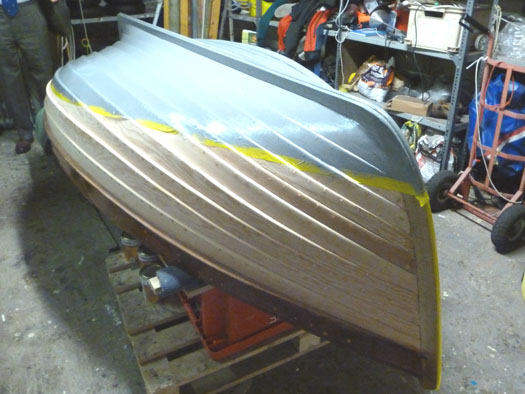
Asgard's dinghy starts to get the finishing treatment. Photo: W M Nixon
It was Fingal boatbuilder Larry Archer (absolutely no relation to the great designer, we're told) who put the little boat together. Like Myles Stapleton when he was tidying up the original drawings of Asgard's lines for a book two decades ago, Larry was very impressed with the way Archer's mind worked, as he designed the transom of the little boat to sit clear of the water when carrying a normal load, thus enabling her to slip easily along without leaving a wake like the inside of a washing machine.

Pat Murphy with Asgard's dinghy. After leading the creation of this little beauty, he understandably has mixed feels about putting her in rugged salt water. Photo: W M Nixon
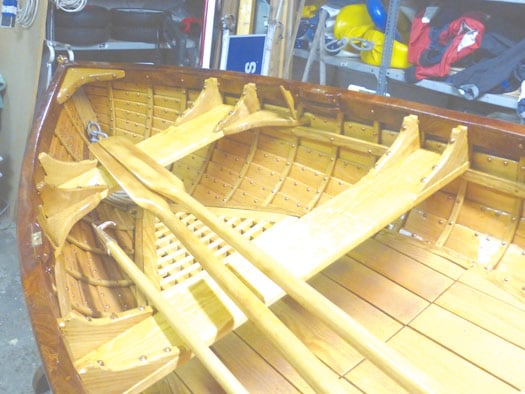
Classic construction and finish detail up forward. Photo: W M Nixon

The interior in the stern – for a ten footer, she is remarkably detailed, particularly where the required twist is put into the planking to maintain a sweet run aft. Photo: W M Nixon
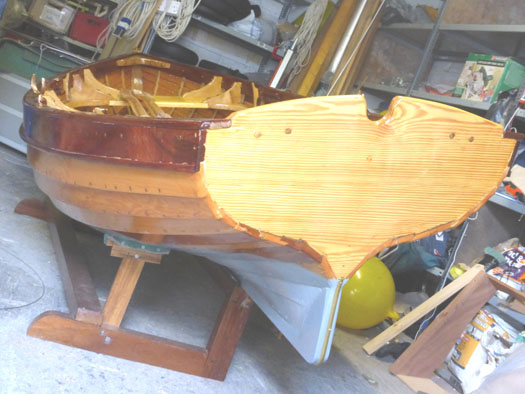
With a clever design to keep the transom clear of the water when the boat is carrying a normal load, Colin Archer created an easily driven yet workmanlike hull. Photo: W M Nixon
It's a remarkable bit of boat design, but with the dry timber it was the very devil to build in the necessary twists.. However, it was done in the end, and the new boat emerged in all her glory, exquisitely finished in classic varnishwork by Pat Murphy and George Elliott, with Neville Maguire making an impressive job of restoring an old set of oars to match the style.
Public debut – Agard's dinghy at Howth Prawn Festival. Photo: Pat Murphy
Asgard's dinghy made her public debut at the Howth Prawn Festival a fortnight ago, and was a star of the show. But the trouble is that when you get a boat finished to this standard, the very thought of putting her into rugged salt water is not appealing. Pat and his team accept the fact that the Asgard dinghy will have to go afloat for the Erskine & Molly Childers Asgard Centenary at Howth on Sunday July 27th. But for now they're much happier just admiring this gem as she shines in the shed, safe from the sea. And who can blame them?
'No Age Bar' as Dublin Bay Sailing Club Surveys Sailors in Wake of National Dinghy Debate
#dbsc – The country's largest yacht racing club is surveying members on dinghy sailing requirements and has also moved to correct a perception that it operates an 'age bar'.
It follows a national debate on the state of dinghy racing that has led to sweeping change at the Irish Sailing Association.
Dublin Bay Sailing Club (DBSC) Commodore Pat Shannon says that the perception the club does not cater for under 18s has taken hold but it is not the case.
Writing on the DBSC website Shannon says 'The DBSC committee would like to make it clear to members, potential members, junior organisers and the wider community generally that such emphatically is not the case. It's a perception but an incorrect one.'
Shannon points to the fact that many boats on the DBSC register (of which there are over 300 and 1200 members) are crewed and sailed by young people under 18. At least three members of the current DBSC committee have sailed on DBSC keelboats since childhood. DBSC activities were recently reviewed by Afloat blogger WM Nixon.
It appears the misapprehension is perhaps understandable though, for while the Club throughout its history has welcomed all comers to membership, regardless of creed, gender or class distinctions, it no longer organises races for juniors. It did so in the past and, when support for this activity declined, joined the Dun Laoghaire clubs in organising the September Sunday series. It still provides logistical support – ribs and access to its results system and web site – but recently it decided not to be classed among the organisers.
This was prompted by the realisation that with the growing emphasis on child protection and parental involvement DBSC was not in a position to accept legal responsibility for an activity which was outside their competence and remit. The feeling was that the waterfront clubs, which were more closely and personally involved in the formation of young sailors, were in a better position to accept this responsibility.
Where some issues might arise with its present programme is with the Club's PY class. In recent times it has provided racing for a variety of Lasers (including Radials and 4.7s), OK Dinghies, RS200s and RS400s, Wayfarers and GP14s. Boats that are sailed uniquely by juniors such as Optimists and Toppers don't easily fit this particular mix. Not for reasons of safety, exactly, but because of potential race management and course setting problems on courses on which they would have to race alongside high performing boats like Flying 15s and Fireballs.
Shannon adds: 'I should add that DBSC, in common with sailing clubs everywhere, is having to review its dinghy programme. As part of this process, dinghy boat owners and others who might be concerned are currently receiving an on-line questionnaire asking for feed-back on the service provided'. The questionnaire is here.
Another dimension is that, with continuing austerity and the need to control its cost base, DBSC committee early this year decided to undertake a long-term strategic review of its racing programme – aiming perhaps for a consolidation of courses, with keelboats and dinghies racing from the a single committee vessel on adjoining or perhaps concentric circuits.
New 'City One' Sailing Dinghy Design Built for Limerick's River Shannon
#cityone – A new Irish sailing dinghy design, the LC1, is under construction in Limerick which promoters say will have a 'lively performance but at the same time, the relatively broad beam and inherent stability should mean it is not difficult for the inexperienced.
The City One Limerick Dinghy from the AK. Ilen Company is designed for use on the Shannon as it passes through the city and opens into estuary on its way to the Atlantic. The LC1's launch will tie in with celebrations of Limerick's 2014 City of Culture celebrtations.
The design of the boat is from the drawing board of Theo Rye.
The keel of the LC1 is laid and according to the latest progress reports the keel of the prototype is laid, and within the next few weeks, some of the world's 'finest craftsmen' from New Zealand, North America and elsewhere will be in the Ilen Boat Building School working in conjunction with Limerick's boatmen on the project.
The design marries traditional and modern design elements. Most modern dinghies are factory made in fiberglass or plastic. The LC1's hull is specifically for relatively simple construction in timber and plywood with a hard chine and constant radius underside.
Many thousands of dinghies of this type were built in the 1950s and 60s, often by amateurs at home. The relative simplicity of the design means no especially difficult boatbuilding skills will be necessary, so the satisfaction of construction is brought into the reach of nearly anyone with enthusiasm and time. The pride of achievement in helping build a boat and then sailing it will excite and interest children and adults, and there are numerous benefits and educational opportunities associated with this process. The materials specified are reasonably cheap and easy to source.
The use of epoxy to coat the timber and fillet the ply together, and the painted finish, will help reduce the maintenance and upkeep often associated with wooden boats, and any repairs necessary should be simple to do as well. The design is also intended to quickly self-drain after righting from a capsize, a feature of many modern designs; "coming up dry" has the benefit of allowing the boats to be left safely on moorings afloat without covers if necessary.
The raked stem reflects that this design is not driven by a rating rule;the stem allows the bow to retain buoyancy when driven hard, and it often means a less abrupt stop in the event of a collision, too. That points to the intention that the boat should be user friendly both for novices as well as more experienced sailors.
In the right hands, the design should enable lively performance and keen racing; but at the same time, the relatively broad beam and
inherent stability should mean it is not difficult or intimidating for the inexperienced or less confident.
The hull shape is intended to be tolerant of crew weight, and allow crews of two, three or even four people, making it a design suitable for teaching sailing with an instructor on board. The high boom and "gnav" mean there is less likelihood of knocking heads with the boom or kicking-strap, and the clear Mylar sails enable good visibility.
The size of the jib is such that even relatively small crew members should find it easy to trim, and without a trapeze no special athleticism is required. The simple layout and lack of complexity in the rig should also mean rigging is quick and easy, helping get people onto the water rapidly and easily.
The Shannon river has always been central to the history and life of Limerick, and sailing right in the center of the city should reawaken an awareness of its fundamental marine and riverine dimension and perspective.
The unique topography of the area brings its own challenges: balancing the need for a relatively generous sail plan to keep the boat moving in the lee of the city buildings with the requirement for a user-friendly and safe boat to sail in relatively confined waters.
The confines of the river mean short legs and lots of manoeuvres, so the hull is rockered to enable quick tacks; there is no spinnaker. The design is also intended for safety in less sheltered waters like the lower Shannon estuary. The relatively high freeboard and built in buoyancy should make it safe under reasonable conditions on any stretch of water from sea to lake to river.
More on this from the AK. Ilen Company here: www.ilen.ie
Dinghy 'DOKRAG' Conference Hears of Big Drop off in Beginner Sailing
#dinghy – If you don't know to which port you are sailing no wind is favourable. It's an old mariners proverb but it held some truth for last weekend's Dinghy & One Design Keelboat Racing Advisory Group (DOKRAG) Convention at the National Yacht Club where up to 40 dinghy enthusiasts resolved to breathe new life into a scene that has suffered a huge fall off in beginners, partly due to the cost of sailing. But how to do it is the next big question. Initiatives like dinghy shows are to be considered and the meeting also identifed huge potential for attracting new sailors into the sport, particularly the twenty–and thirty-something's who may be moving from traditional team sports, into the burgeoning "adventure sport" arena
But building theories based on small pieces of evidence is not that scientific so in the absence of data that can be relied on, the meetings findings must be taken with a pinch of salt.
One such statistic to emerge from the conference was that Ireland's racing fleet is 2000 active boats (including the ICRA cruiser nationals fleet) and 6000 active racers.
The presentation of a project to standardise collection of data from classes by Sean Craig was very worthwhile and an important first step but it is clear that the advisory group charged with trying to make sense of the dwindling figures are still coming to terms with existing numbers in the sport. Craig's powerpoint presentation is available to download below.
This was the first time, since its formation, that the group has met with the classes. This was the first of a number of proposed consultative meetings. The key themes were data collection (existing and future) and future development.
Significantly, the meeting of dinghy class interests included members of the newly formed ISA Strategic Review Group who were no doubt interested in hearing about the numbers currently involved in dinghy sailing, a back bone of the sport in Ireland.
The SRG has been formed specifically with the task of coming up with a new plan for Irish sailing and any future plan will include a means to boost flagging fleet numbers where it was largely agreed any class championships that currently has only 10 to 15 participants in not viable in the longer term.
Data
The DOKRAG considered that any Advice offered must be based on fact and looked at the available data, and ascertained what other data was necessary to make fully informed recommendations.
Existing data of participation in National Championships was presented and analysed. (see slides) This data challenges the consensus that senior dinghy racing classes are in decline.
This data is National Championships only (so no Water Wag or Howth 17 for example), excludes overseas visitors and is based on nominations for the ISA All-Ireland (ex Helmsmans) Sailing Championships.
Key trends
1/ Senior Dinghy classes are up 6% 2008-2013, although on a ten year view there is a 5% dip, due largely to falls in larger designs such as Wayfarer, Multihull and Fireball.
"Traditional classes" (Mermaid, SOD, IDRA 14, Nat 18) are largely unchanged. There is continued strength in GP 14 and Laser and gradual increases in RS classes.
2/ Junior classes show a worrying 28% decline in the last 5 years, led by more "fun-oriented classes" like Feva, Topaz and now even Topper. Mirror appears to have consolidated well at lower levels and was, in fact, the second largest regatta by people in 2013. Numbers remain high in ISA Pathway single handers like Optimist and Laser, although the Optimist has seen a fall in the last 5 years. Single handers account for a very high 69% of all boats competing, in stark contrast to Senior dinghies where Double handers are 94%.
3/ Keelboat numbers show a downward drift in total but there is a negative skew from the explosive growth of the SB-20, which has fallen and is hopefully consolidating at the 20-25 boat level from 50+. Possibly more expensive and larger boat-types like Dragon, Etchells and even 1720 appear to be faring less well than smaller designs like the Squib and Flying Fifteen that continue to stage Championships with at or close to thirty boats.
4/ Cost is a probable causal factor for lower turnout given better performance by smaller boat types in each category.
5/ Overall numbers should be seen in the context of the following; Static or declining
Cruiser/ICRA numbers, big decline in Learn to Sail/Small Boat Scheme numbers (down over 50% in 5 years), the fall in ISA membership (20% in 5 years) and, of course, the recession.
6/ Junior racing numbers appear, not surprisingly, to have been closely correlated with the numbers participating in the ISA Small boat training scheme with large increases in both 2004-2008 and sharp decreases in both thereafter. SSB 2012 certification numbers were still 5,200 and over 450 Instructor certification courses have been completed in the first 3 quarters of 2013 (up from just 160 in full-year 2005 for example). These are included in the analysis for possible relevance to overall racing population numbers.
7/ Adjusting for crew per boat and adding in the Team/Match racing sector/events, produces an estimate of 2,161 people participating in Irish National Championships in
2013.
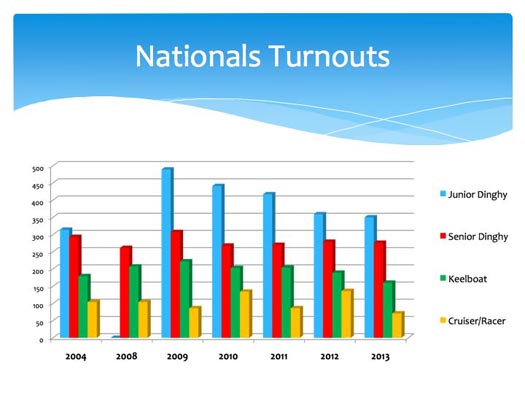
However, it was recognised that the number of those participating in National Championships is only a proportion of those regularly sailing in those classes. It is estimated that the number of regular, club sailors could be a multiple of 2 or 3 of these figures, with variations between classes. While this additional data is not currently available, it would be important if the true profile of dinghy/open keel sailing in Ireland is to be identified. This is best done through the classes. A draft template for such future data collection was shown to attendees, the template will be refined based on feedback, and then circulated to classes for completion. The aim is to get an accurate profile of age groups, gender, distribution of classes through various clubs, costs incurred, and racing opportunities and participation at a local level.
Development
Future Development of dinghy sailing was then considered,with active participation from delegates. The following had been identified as key issues, by the Group.
1. Impediments to the progression of a sailor from a Learning to Sail course, to becoming
a regular club sailor were discussed.
2.Cost. While cost was a consideration, the actual cost of participating in dinghy sailing need not be expensive. Costs of participating in sailing need to be quantified, and minimised for newcomers to the sport, both adult and junior. Cost does not only include boats and equipment, but participation in racing through entry fees, travelling expenses, etc
3. Transition from youth classes to senior classes was seen as a key issue, and needs more analysis.
4. A similar Consultation between DOKRAG and the Clubs will also be undertaken.
It is too early to give comprehensive recommendations from DOKRAG, as this is still the consultative phase. Some preliminary steps were discussed with the delegates to assess whether they merited further development:
1. encouragement of those who have completed the Small Boat Sailing scheme (SBS) to participate in racing at local level, as racing hones their new skills. (adult & junior)
2. Consider a "Irish Student Sailing Championship" open to all registered students in Ireland. Those over 18 cannot participate in the Youth Nationals. While students can race in class events, such as laser, at club level, or in University Team Racing events, but there is a high attrition rate of sailors after 18. There is no large, multiple-fleet regatta aimed specifically at this age group. The concept was supported by those present and deserves further evaluation.
2. There is huge potential for attracting new sailors into the sport, particularly the twenty- and thirty-something's who may be moving from traditional team sports, into the burgeoning "adventure sport" arena. Marketing opportunities to attract this group into sailng.could be pursued.
3. A Dinghy Exhibition would give an opportunity for the general public, and those who have completed SBS schemes, to see/try all classes of dinghies, particularly if combined with an on-the-water experience. The concept was supported by those present and will be explored further.
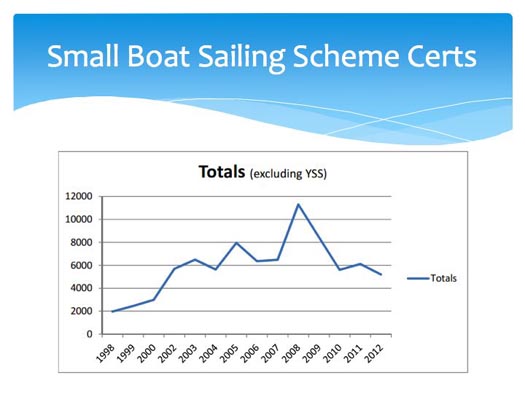
Big Task Ahead for Small Boat Forum as Data Shows 'Sport on its Knees'
#smallboatforum – In anticipation of the small boat forum to be hosted next Saturday morning in the National Yacht Club, Roger Bannon has tried to gather some information over the last 2 years on attendance at class championships for dinghies and small keelboats.
In Ireland we have about 20 recognised small boat and dinghy classes made up of single handed, 2 handed and 3 handed boats.
Based on the data I looked at, approximately 700 boats participated in a National Championships with an average of 1,300 Irish competitors involved in 2012 and 2013.
The statistics make interesting reading;
33% were single handed boats
45% were two handed boats
22% were three handed keel boats and large dinghies.
The number of active participants was split as follows:
Single handed 18%
Two handed 47%
Three handed 35%
Assuming that most participants in singlehanded classes such as the Oppy, Topper and Laser Radial and 2 handed classes such as the Feva and Mirror are under 23 years of age, this group together with a few who were involved in other classes, made up about 40% of the total individuals involved.
The active pool of remaining older competitive sailors involved in small keel boats and dinghies is less than 800 individuals! Nearly 500 of them raced in Mermaids, SB20s Shannon One Designs, Squibs, National 18s and Flying Fifteens with less than 300 people sailing other more performance oriented classes.
Clearly this is not indicative of the numbers involved in club and other recreational small boat sailing activities but it is a very stark analysis of the current competitive situation for so called prestige events!
The harsh reality in Ireland is that we probably have fewer adults racing small boats competitively in recognised championships all year than sail on any Thursday evening in Dublin Bay Sailing Club!
Even if the figures are wrong by 50% the message remains materially the same. With exception of a small number of established classes, competitive small boat sailing in Ireland is clearly on its knees.
How can we reasonably expect to produce world class sailors from this modest environment?
The scope of the challenge is awesome!
ISA Hosts Convention To Discuss Dinghy Racing's Future
#ISA - The Irish Sailing Association has issued an open invitation to dinghy sailors to discuss the future of dinghy and one design racing in Ireland at a special meeting less than two weeks away.
The Dinghy & One Design Keelboats Convention will take place on Saturday 2 November at 10.15am in the JB Room at the National Yacht Club in Dun Laoghaire.
Chaired by Margaret O'Donnell, the convention follows on from the classes forum this past March, which led the ISA Board to establish a Dinghy/One Design Racing Advisory Group.
That meeting also prompted Ric Morris' suggestions for five things the ISA could do to rejuvenate dinghy sailing in Ireland. His salient points will surely provide much fodder for discussion on the day.
Dinghy Capsize Prompts HM Coastguard Rescue of Five
Two adults and three children have been rescued from the water after their dinghy capsized off Gwbert, in North Wales.
Milford Haven Maritime Rescue Coordination Centre (MRCC) received a 999 call just after 11am reporting that a group of people were in the water yesterday morning.
The Cardigan Coastguard Rescue Team and the Cardigan RNLI inshore lifeboat were sent to the scene. The lifeboat located those in the water and managed to get them all on board. They were taken ashore where they were met by the Cardigan Coastguard Rescue Team and ambulance crews.
Bob Peel, Watch Manager at Milford Haven MRCC, said:
"The two adults and three children were well equipped as all were wearing lifejackets. They were rescued from the water uninjured, just cold and shaken from their ordeal.
"We always want people to have fun but stay safe when out on the water. That's why we always recommend to those heading out in a boat, canoe, kayak and such like, that they should wear an appropriate lifejacket or buoyancy aid. It's useless unless worn and could save your life."
Support of Irish Dinghy Sailing Needed
#dinghy – Just because Irish dinghy and one design fleet attendances appear to be holding up well in recession doesn't mean there is nothing of concern in the numbers involved in what is the backbone of Irish sailing.
In fact, there's probably a window here for about five years while the domestic classes still have reasonable numbers, but a lot of the current crop of senior sailors are getting older. After that, the whole scene could really nose dive, not helped by lack of cash amongst 30–50–year–olds, which will stymie the future growth of junior sailing classes such as Oppies.
More dinghy sailing promotion on so many levels is needed to bring new blood into the sport. Euro for euro it is so much more deserving than some other waterborne initiatives this season.
This weekend the first ever staging of a World championships on Ireland's inland waters takes place on Lough Derg with the Mirror worlds. Next month, the Olympic Laser class European championships sets sail on Dublin Bay.
It illustrates a buoyant scene for now and one that accurately supports claims made by sailors last Spring that much more should be done to promote dinghy and one design sailing.
There is still the same 20-40 boat fleet sizes and strong participation in classes like Lasers, RSs, GP14s, Fireballs, Mermaids, SODs, Wags, FFs, SBs and Squibs. This month, RS titles were decided in a record breaking turnout on Belfast Lough.
There was confirmation of this at this month's Volvo Dun Laoghaire regatta with SB20s, FFs and Squibs all healthy at about 20 each and on the dinghy course you had Laser Standards, Fireballs, Mermaids, IDRA 14s and Water Wags all in double figures. A couple of new–fangled Moths too!
Of particular note was the Beneteau 21 keelboat fleet – now dubbed the Dublin Bay 21 – racing as a one design class for the first time.
Last weekend in Skerries, 15 contested the Irish Fireball title (well done Kenny and Dave), a hundred fought for three Laser titles on Lough Ree (well done Chris, Seafra & Cliodhna).
And to add to the point at a local level, last week, the National Yacht Club hosted its biggest ever junior event with a combined fleet of 180-boats off Dun Laoghaire, for a club regatta!
On the downside, it is disappointing Dragon numbers are low but that's pure economics isn't it? Wayfarers have cancelled their National Championships in Wicklow too.
Overall, we should not be complacent because of a seemingly buoyant summer period. All is not well.
This week Glenans Sail Training Association signalled problems at its operations in Collanmore and Baltimore, traditional strongholds for adult dinghy sail training.
As we know in any yacht race, if we are becalmed, we fall behind. We need to find the new wind. There is a need to grow the sport through the extensive Irish club and class network, otherwise it will die.
Support of dinghy sailing at junior, local and national level can have far reaching benefits for all aspects of the sport, a point well made last April by dinghy and one design delegates at the National Yacht Club workshop in Dun Laoghaire.
Dinghy Man Rescued Attempting Daft UK-Ireland Crossing
#CelticSea - A British man's unorthodox attempt to cross the Celtic Sea from Dorset to Ireland has come to an end after he was rescued by the UK coastguard.
A RTÉ News reports, the man was discovered some 2.7 nautical miles south of Durdle Door on Dorset's Jurassic Coast in a 6ft inflatable dinghy.
He was found with two paddles - one being used with a plastic sheet as an improvised sail - plus a limited amount of food and drink, and no suitable communication or lifesaving gear.
Rescuers later brought the man back to shore where he was treated for severe sunburn.
RTÉ News has more on the story HERE.





























